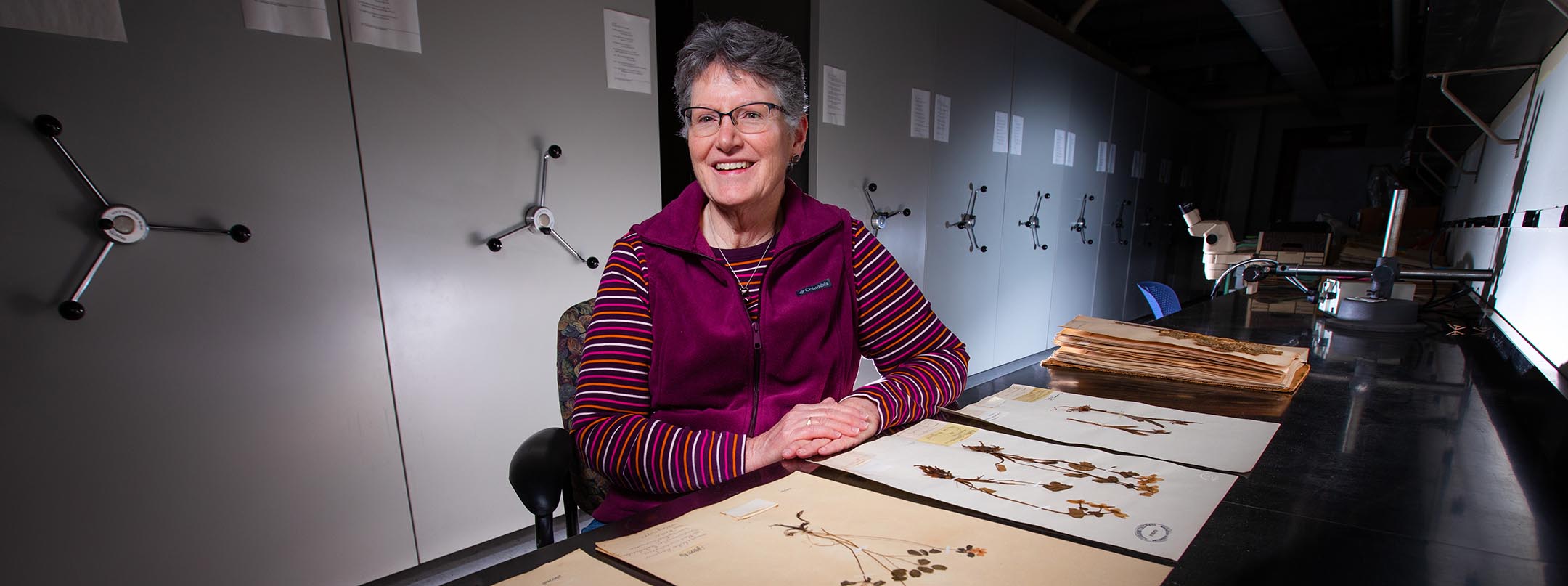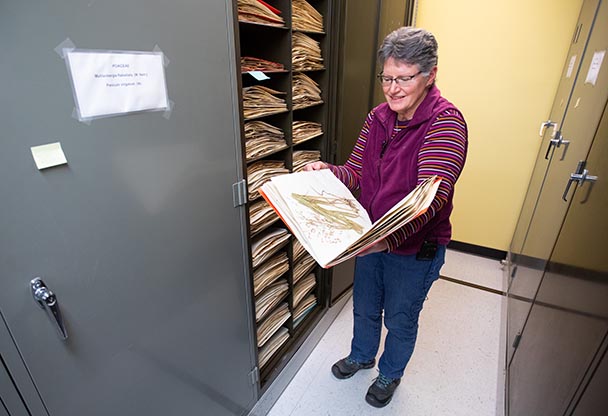Written by Dave Roepke | Photos by Christopher Gannon
Jan. 23, 2024
Stewarding specimens connects curator to plant lovers

Asking a parent to name a favorite child is an unfair question. Same goes for Deb Lewis and the more than 700,000 plant and fungi specimens held in Iowa State's Ada Hayden Herbarium, where Lewis has been the curator since 1984.
"We don't know which specimen will be important to someone's research, so we give great care to them all," she said.
Some of those specimens have been cared for more than 150 years. The herbarium was founded in 1870, a year after the university held its first classes. Seeing plants preserved by scientists who are among Iowa State's most celebrated early scholars is one of the joys of Lewis' job, a reminder of the herbarium's deep roots, she said. "For many different reasons I have many different favorites, but I'm pretty amazed whenever I come across specimens from our most historic collectors," she said.
That includes samples collected by George Washington Carver (renowned agricultural researcher and Iowa State's first Black graduate and faculty member), Charles Bessey (herbarium founder and namesake of the building where it's located) and Ada Hayden (preservationist who was Iowa State's first female doctoral graduate and, since 1988, the herbarium's namesake).
Stewarding the specimens provides Lewis a gratifying link to botanical history, but interacting with present-day plant lovers has just as much to do with remaining in her post for 40 years.
"I'm pretty passionate about sharing information about this place," she said. "There have been very, very, very few days where I've felt like I didn't want to go to work."
Making connections
An herbarium is a repository for botanical specimens, most of which have been dried, pressed, annotated, affixed to archival paper and stored for reference. At the Ada Hayden Herbarium, which occupies four rooms on the third floor of Bessey Hall, specimens are stacked on shelves in about 250 large metal cabinets. It's essentially a plant library -- a fitting combination of childhood interests for Lewis, who helped with the garden when outside and curled up with a book when inside.
Lewis started as an English major at Arkansas Tech University, Russellville, before a dynamic botany instructor inspired her to switch her major to biology. That led her to work in the school's herbarium.
When she was hired at Iowa State after earning a master's degree in botany from University of North Carolina, Chapel Hill, she was the first full-time staff curator since the 1930s. At the time, herbaria still frequently took submissions from faculty and graduate students conducting floristic research -- a survey of all plant species in an area.
In recent decades, as methods for studying plants have advanced, widespread collection is less of a research priority, and the rate of new additions to the herbarium has slowed – though there's still more than enough waiting to be mounted to keep Lewis' four-person student team busy.
"These days, it's more hobbyists," Lewis said. "The upside is we do have many people in Iowa who get excited about native plants."
For many years, that included Jimmie Thompson, a former Ames postal carrier with no formal botany education who conducted and published numerous surveys of Iowa flora -- some with Lewis as co-author. Lewis founded the Iowa Native Plant Society with another frequent herbarium collaborator, Bill Norris, an ISU doctoral graduate and biology professor at Western New Mexico University, Silver City, who curates the herbarium there.
Establishing the Iowa Native Plant Society is an example of how devoted Lewis is to service and ecological preservation, said Lynn Clark, professor and interim chair of ecology, evolution and organismal biology.
"That wouldn't have happened without Deb. She's made a big difference for conservation in Iowa," Clark said.
A close partnership
Clark and Lewis have a long and constant history of working side-by-side. When Lewis interviewed for the position, it was Clark -- then a graduate student -- who picked her up at the airport and took her to eat at Hickory Park. After being hired on as faculty, Clark was appointed director of the herbarium in 1989 and has supervised Lewis ever since. Over that time, they've developed a close partnership.
"Lynn and I have really gotten along well. We've talked about herbarium practices and issues for years and are very much on the same page," Lewis said.
Or as Clark noted: "I don't even have to think about it, and she's already done it. She knows she can tell me what I need to hear and likewise. There's a lot of mutual respect."
Lewis manages the herbarium's day-to-day operations, including research assistance, loan requests and outreach. She excels at explaining scientific concepts to visitors without a botanical background, Clark said. She's also a top-notch plant identifier, especially those native to Iowa, a crucial ability when leading a facility often called upon to solve plant mysteries.
"Deb is just really good at identification. It's a skill you need to have in her position, and she's definitely got it," Clark said.

Specimens from all of Iowa's public universities
While the herbarium's collection remains relevant for increasingly varied research uses, such as sampling DNA and tracking biodiversity, it takes on even greater importance as a one-stop-shop for studying Iowa flora now that it's the only herbarium at a state Board of Regents institution. Iowa State absorbed the University of Iowa's collection in 2004 and the University of Northern Iowa's last fall. Those additions are the major driver behind the number of specimens doubling over the last four decades.
Integrating the Iowa and UNI specimens and continuing to digitize as much of the overall collection as possible will be an ongoing effort for years, if not decades, to come Lewis said.
"We want to maintain continuity for the future and keep making it more usable now," Lewis said. "That's probably a forever project."